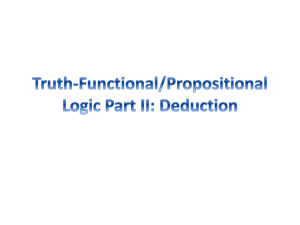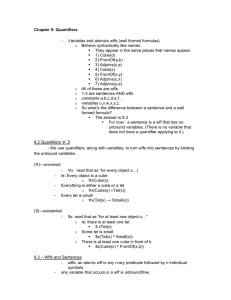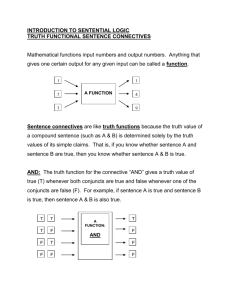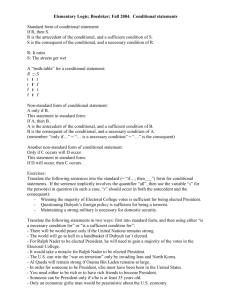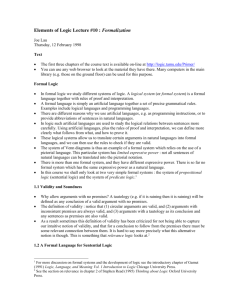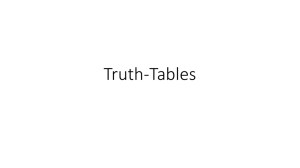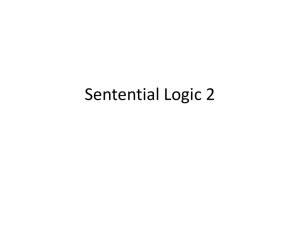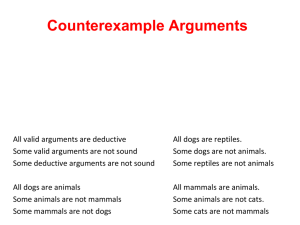Truth Tables
advertisement
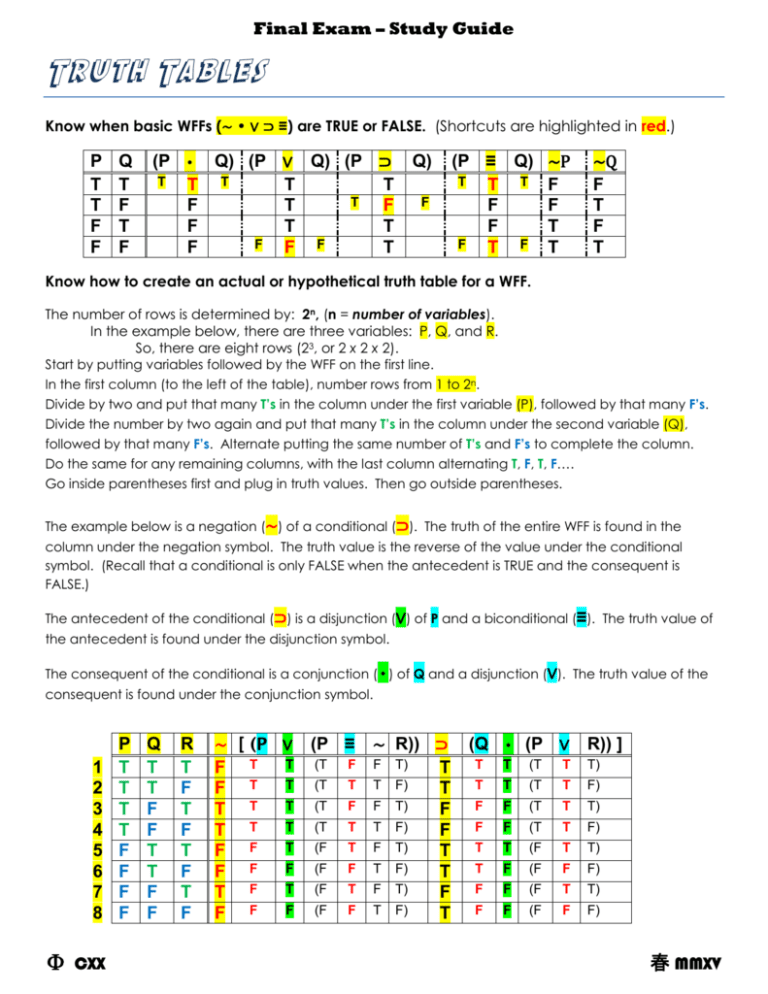
Final Exam – Study Guide Truth Tables Know when basic WFFs (∼ • ∨ ⊃ ≡) are TRUE or FALSE. (Shortcuts are highlighted in red.) P T T F F Q T F T F (P • Q) (P ∨ Q) (P ⊃ T T T T T T F T F F T T F F F F T Q) F (P ≡ Q) ∼P T T T F F F F T F F T T ∼Q F T F T Know how to create an actual or hypothetical truth table for a WFF. The number of rows is determined by: 2n, (n = number of variables). In the example below, there are three variables: P, Q, and R. So, there are eight rows (23, or 2 x 2 x 2). Start by putting variables followed by the WFF on the first line. In the first column (to the left of the table), number rows from 1 to 2n. Divide by two and put that many T’s in the column under the first variable (P), followed by that many F’s. Divide the number by two again and put that many T’s in the column under the second variable (Q), followed by that many F’s. Alternate putting the same number of T’s and F’s to complete the column. Do the same for any remaining columns, with the last column alternating T, F, T, F…. Go inside parentheses first and plug in truth values. Then go outside parentheses. The example below is a negation (∼) of a conditional (⊃). The truth of the entire WFF is found in the column under the negation symbol. The truth value is the reverse of the value under the conditional symbol. (Recall that a conditional is only FALSE when the antecedent is TRUE and the consequent is FALSE.) The antecedent of the conditional (⊃) is a disjunction (∨) of P and a biconditional (≡). The truth value of the antecedent is found under the disjunction symbol. The consequent of the conditional is a conjunction (•) of Q and a disjunction (∨). The truth value of the consequent is found under the conjunction symbol. 1 2 3 4 5 6 7 8 CXX P T T T T F F F F Q T T F F T T F F R T F T F T F T F ∼ [ (P ∨ (P ≡ ∼ R)) ⊃ T (T F F T) F T T T T (T T T F) F T T T (T F F T) T F T T (T T T F) T F F T (F T F T) F T F (F F T F) F F T T (F T F T) T F F F F (F F T F) F T (Q • (P ∨ R)) ] T T (T T T) T T (T T F) F F (T T T) F F (T T F) T T (F T T) T F (F F F) F F (F T T) F F (F F F) 春 MMXV Final Exam – Study Guide Indirect Truth Tables Know how to prove validity or invalidity of an argument with an indirect truth table. Start by putting variables followed by the premises and conclusion on the first line. Make the conclusion FALSE. If possible, make all premises TRUE. Start with simple WFFs and plug in the truth values derived. If all premises can be TRUE while the conclusion is FALSE, the argument is invalid. As in the example, the argument is valid if it is impossible to get all TRUE premises and a FALSE conclusion. T B T F M F H F T T (T ⊃ (B ∨ M)) T F F F F (M F ⊃ H) ∼H T F T F ∴B F S-Rules and I-Rules Know how to derive conclusions based on the assumption that a WFF or pair of WFFs is TRUE. Refer to Gensler’s handout for details: http://harryhiker.com/lc/docs/prop1.pdf (pp. 23 – 27) Proofs Know how to prove that an argument is valid by using S-Rules, I-Rules, and RAA. Refer to Gensler’s handout for details: http://harryhiker.com/lc/docs/prop2.pdf (pp. 1 – 10) Translations Know how to translate English sentences into WFFs and paragraphs into arguments composed of WFFs. Refer to Ch. 6 of the textbook for an explanation. CXX 春 MMXV
